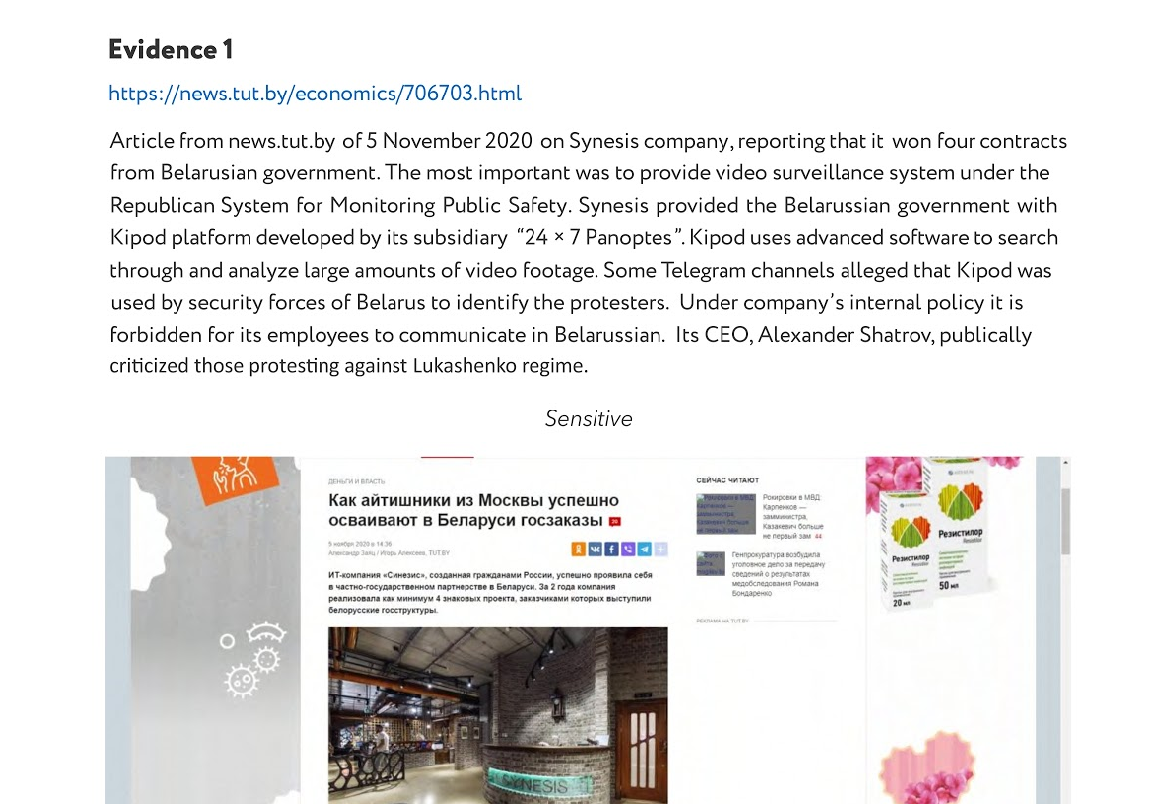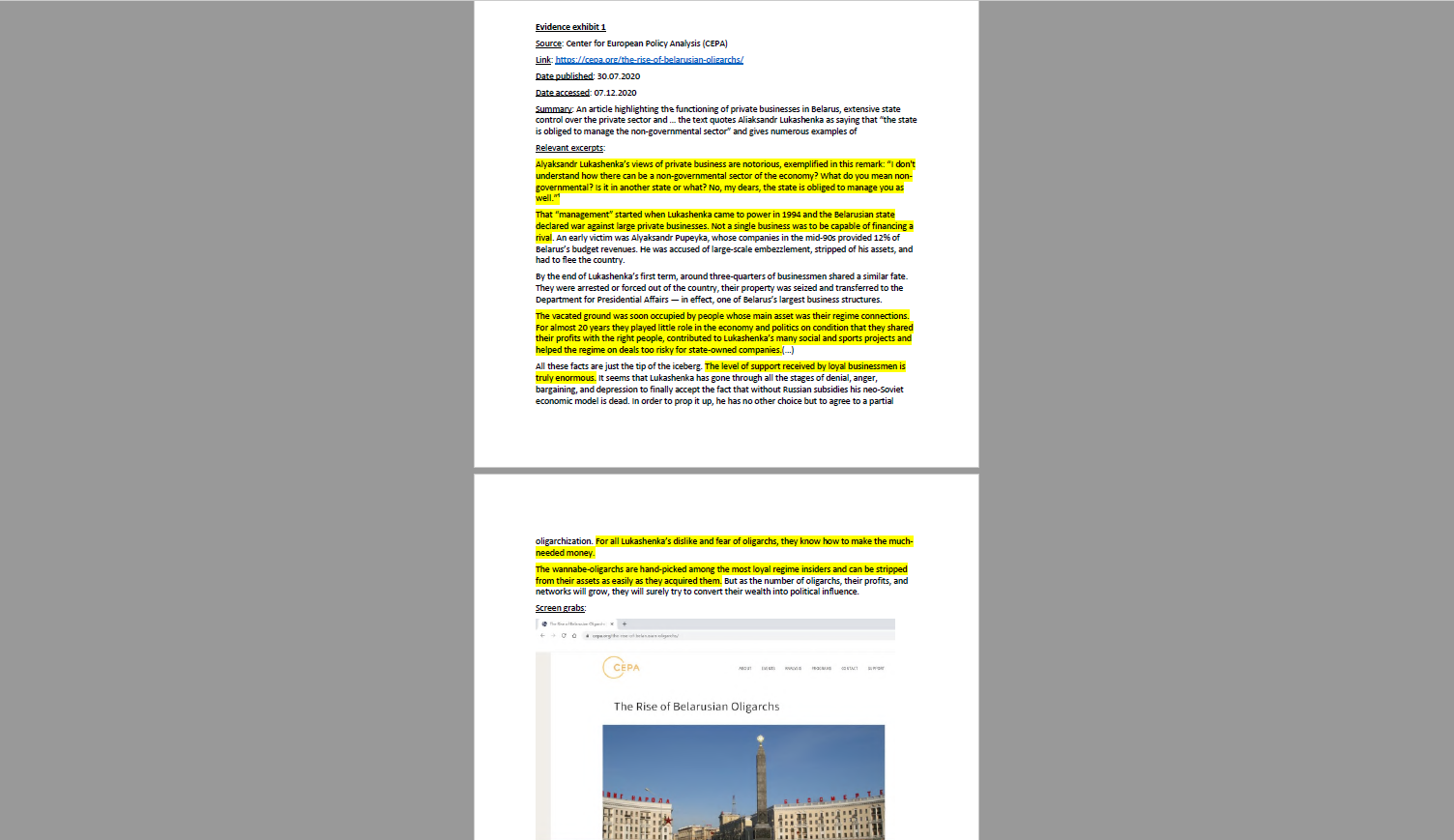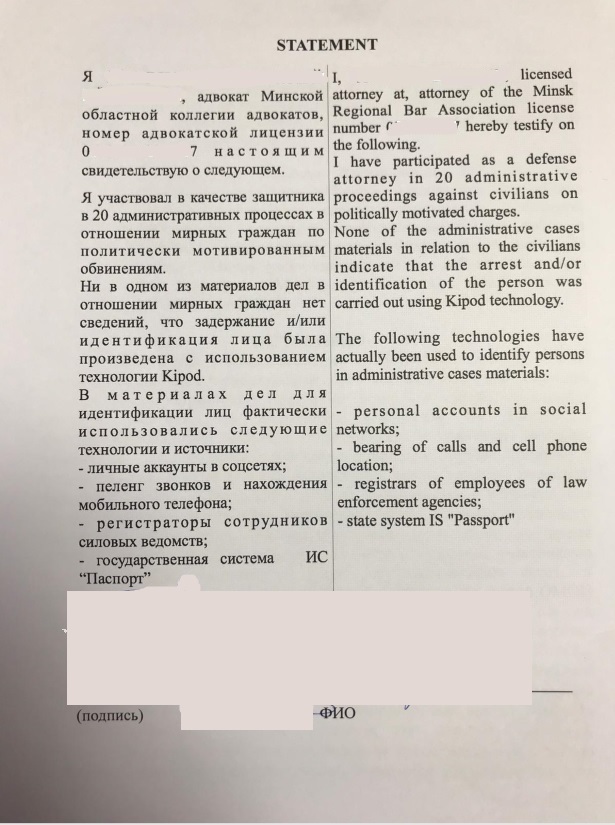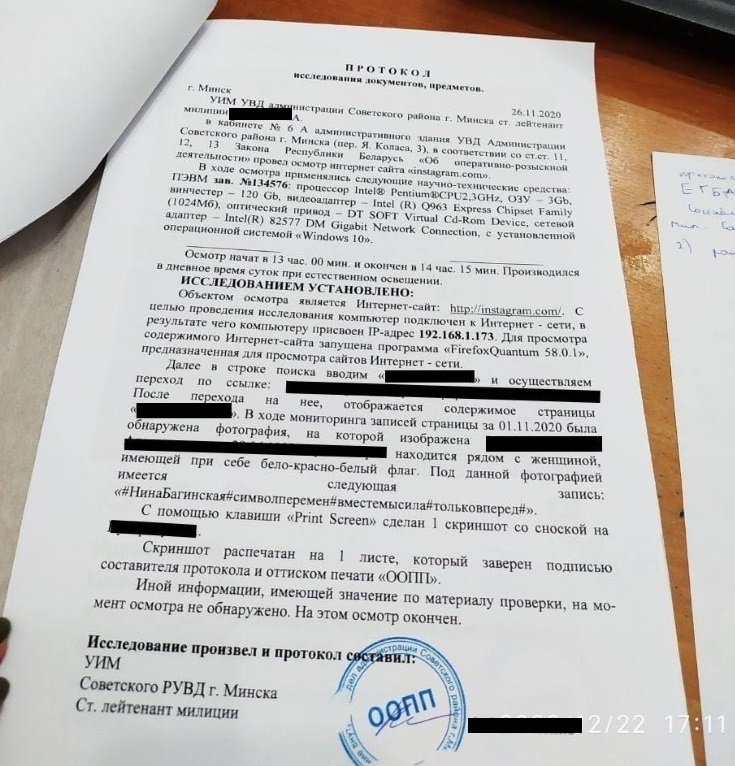***
Synesis LLC filed the statement of claim to the Court of Justice of the European Union to invalidate the decision of the Council of the European Union to include the company in the third package of sanctions against Belarus. We consider all accusations against the company as not only far-fetched, but also absurd. In its decision, the Council did not operate with facts, but exclusively with speculations from social networks and web pages with a doubtful reputation. The “evidential base”, in its imprecision and vagueness, looks more like a tabloid press digest and could not serve as the basis for consideration by such a responsible body as the Council of the European Union.General disregard of basic principles by the European Council
The first sign of an unprofessional approach in resolving the issue is that the Council could not determine either the form of ownership of the company or its management, which has always been publicly available and easily accessible information. That being said, in the decision of the Council of the European Union, the company is named as a “joint-stock company”, although it is a “limited liability company”. In addition, its co-founder Alexander Shatrov, who has never been the CEO of Synesis, is designated as the executive director of the company.
A faulty operations procedure exercised by the Council of the European Union is also manifested in the fact that two different – from legal point of view – companies were included in the list. That is, two legal entities registered in two different jurisdictions – in the Republic of Belarus and in the Russian Federation. The Russian legal entity does not operate in the Republic of Belarus and cannot in any way be involved in the arrests in Belarus (even theoretically). Already at these stages, one can see the “enthusiasm” with which the responsible persons of the Council of the European Union approached the case.
But the most important evidence that the Council did not check the compliance of information with the basic criteria and took its decision hastily, is the package of documents with the “evidential base”. These are exceptionally screenshots of speculative articles, and in some cases – only excerpts of the text, made with machine translation. How does it look like in the official EU documentation? Example No.1, example No.2. Imagine you applied for a Schengen visa in the same form: you provide screenshots with your name in the articles as a confirmation of employment, and translate them entirely through Google Translate. What would be the response from any embassy of the EU member-state?
According to the Council of the European Union, one of the main evidences of violation of human rights and freedoms in Belarus looks as follows:

To set things straight, “the final straw” that the Council of the European Union brings in in the second document – is a digest of articles about corruption in Belarus, which contains no mentioning of Synesis at all:

From bad to worse, the supporting document of the Council (WK 14796/2020 EXT 2) is dated the same date as our request, therefore, it was prepared after the adoption of the sanctions package, that is, “retroactively”. It turns out, that rumors that the final version of the sanctions list was cobbled together in someone’s garage in a mad rush, are not just rumors. Now the Council has to build the “evidential base” on the go.
We smoothly approached the most interesting part – the specific reasons for which Synesis happened to appear on the sanctions list. They are absurd to such an extent, that they raise questions not to Synesis, but directly to the Council of the European Union which allowed fake news to influence the decisions not only in business, but also in politics.
Accusation No.1: Synesis provides the Belarusian authorities with a surveillance platform, which can search through and analyse video footage and employ facial recognition software, making the company responsible for the repression of civil society and democratic opposition by the State apparatus in Belarus.
The main reason for sanctions is the project called the “Republican Public Security Monitoring System” (RPSMS), which is based on the Kipod Smart City system with a face recognition feature developed by Synesis.
The first “information attacks” against Synesis argued that the RPSMS massively identifies protesters on the streets of the country. However, they forgot to explain to an impressionable audience that Kipod is technically incapable of performing such tasks. It is based on a completely different logics: search by predefined objects. To make it clear: the system does not recognize and does not enter into the database every person from the crowd, but, on the contrary, seeks through the crowd for someone who is already entered in the base. It is impossible to add all the residents of the country or even Minsk to the database, since the system simply cannot process such an amount of data. At the same time, almost all cameras connected to the RPSMS in Minsk are placed in metro and at the railway station – in locations, where the protests did not take place.
That is, basically, the system cannot identify unknown protesters – and certainly – in a massive scale. Likewise, one cannot upload a third-party video (for example, from a portable camera) to the monitoring system in order to identify people on such video. The Council of the European Union was provided with technical documents confirming the impossibility of mass identification, and it was also proposed to conduct an independent technical audit. All our requests were ignored, same as the fact that there is no single order, issued by executive bodies, that mentions our system. In other words, there is no single case of using RPSMS for identifying protesters.
An impressionable audience of social networks may object: “today the system cannot do this, but tomorrow it can!”. It is unimaginable nonsense to accuse someone of hypothetical violations (“hypothetically, a human being could cause someone harm with his hands, which means let’s arrest everyone having hands”), but still, let’s get rid of everyday logics:
1. Updating the software will require millions of dollars, and upgrading the hardware will require tens and hundreds of millions of dollars, and much, really much time.
2. It has no practical value as simple and effective technologies that do not require special financial and resource costs are used for mass identification and detention of protesters. For instance, mobile network operators, social networks, online media, or internal systems are used by law enforcement. Together with human rights defenders, we analyzed hundreds of protocols and resolutions in which the accused were mentioned as being identified by technical means. Absolutely all resolutions mention one or several of the above means and tools. No one needs multimillion-dollar investments in sophisticated smart city technologies while they can request a ready-made, nicely-designed statement with data on the location of thousands of mobile network users. Surely the Council has known this method for a long time. But if the mobile providers operating in Belarus are brought to justice, then perhaps this decision will run counter to the business interests of European companies in Belarus.
As regards social networks, there is no even question of their built-in face recognition systems: people independently mark themselves and their acquaintances in the photo, not forgetting to make their profile public. As a result, there are many resolutions mentioning social networks.
Finally, Telegram channels and media (including independent ones), which publish reports from protest rallies and show the faces of the participants, help to find and identify citizens. At the same time, the editorial offices know that their materials help to arrest the protesters, but they adhere to an editorial policy prohibiting retouching faces (“people are adults, everyone knows where they are going, what they are doing and what the consequences may be” – this is the position of the well-known online media, which materials appear in real protocols and resolutions). Relying on such resources and evidence, the investigating authorities carry out arrests and bring charges, for which people receive real prison terms and fines. The portal itself is tactfully silent about this, continuing to create myths about Synesis.
All the above is confirmed by many real protocols and resolutions, but we have not seen any resolutions mentioning RPSMS, Synesis or Kipod.
Below you can see the reports of law offices and lawyers, which helped us to hold our own investigation. We got a permission to publish these documents, subject to anonymization:

And these are the protocols and decisions, in which, with the finest details – including the versions of the software used and lighting level in the office – the procedure for establishing the circumstances of offenses is described:

Similar statistics are confirmed by other law firms and volunteer movements – no one has seen references to our systems in the case materials. What is more interesting: when they tried to convey this in the comments to provocative posts in anarchist channels, their messages were massively deleted. But the fact remains: there is not a single protocol, resolution or decision mentioning Synesis or any of its products in the EU Council’s “evidence base”. But the company was included into the sanctions list. While the web media (plus cellular operators, DVRs and CCTV manufacturers, US developers of software for Internet blackout) documented in numerous protocols are not. On the contrary, the Council builds accusations against Synesis on the basis of speculative materials published on such resources. Resources, which are the base for real administrative and criminal cases against Belarusians. You can determine the level of cynicism by your own.
3. Contrary to what the European Council claims, Synesis does not operate the system. Even if the system were actually used to identify demonstrators, the company cannot be held responsible for the actions of the system users, same as Microsoft is not responsible where anyone on their PC breaks into the data system of an EU institution. It is inappropriate to defend or even apply this kind of broad concept of responsibility.
Also, the EU Council accuses that tens of thousands of CCTV cameras are connected to the platform. This claim is completely false and serves as a very good example of the low level of information that the Council considers as evidence. At the time of this accusation, only about 700 cameras were connected to the RPSMS, of which 515 at metro stations. Note to the Council: an explanation of the procedure for using the video analytics system in Belarus, indicating the main locations, was published by Synesis back in October 2020 – immediately after receiving the first accusations from Telegram channels.
As regards the Smart City systems with the face recognition feature, they are widely used in all EU countries, and, moreover, this market is considered highly competitive. Every year in European capitals, multimillion-dollar tenders are held to connect thousands of cameras at certain facilities, and not only developers, but also the cities compete in the technological race. In Belarus, Smart City technologies are being deployed much more slowly and in negligible proportions compared to the EU countries. Kipod was developed specifically for use in advanced foreign markets and does not have special functionality within the framework of the RPSMS project. Its main purpose is to improve the safety of citizens and search for missing people.
Taking this into account, we can state with full confidence that a clear fake news campaign has been launched against Synesis, which, through news feeds based on primitive logic, serves someone’s political and business goals.
Telegram channels and online media demonstrate particular cynicism in the “search for the guilty”. They are the cause of hundreds confirmed administrative and criminal cases, destroyed families and the fate of citizens, but they continue to publish unconfirmed information on their pages, while keeping silent about the real danger. Are hype and material’ views and sharings more valuable than people’s freedom? Indeed, why should they tell the truth, if they can hype on the topic of technological phobias and Synesis?
Accusation No.2: Synesis employees are forbidden from communicating in Belarusian, making the company responsible for undermining labour rights
Already from its wording and purpose the allegation related to communication in the company cannot be considered as a lawful reason to list Synesis. It does not imply responsibility for the repressions and undermining of democracy in the country.
However, the “evidence” is based on a Synesis co-founder Alexander Shatrov statement in his interview on Dev.by on December 10, 2019, which was taken out of context. He noted that in work processes (for example, in chats), one cannot use languages that are incomprehensible to most of its participants.
Shatrov explicitly states that this is not limited to the Belarusian language, but applies to any language that all participants in a particular dialogue do not know – for example, Spanish, Ukrainian or Italian. This is a generally accepted practice, common business ethics and a simple rule of good manners when people interact with each other in a language that all participants in the dialogue understand.
This practice is also used in global IT corporations. Synesis employees do not and have never had any restrictions on the use of the Belarusian language in situations where it is understood by all participants in the dialogue, including in person communication. The same applies to any other language, such as Russian, French, etc., as well as the use of national symbols, freedom of expression of civil position by employees in and outside the office. And again: when company employees tried to convey this in the comments to provocative posts in Telegram channels, their messages were deliberately deleted upon only negative replies were left for a sinister image of a company.
Accusation No.3: The Belarusian State Security Committee (KGB) and Ministry of Internal Affairs are listed as users of the system created by Synesis. The company is therefore benefiting from and supporting the Lukashenko regime.
Let us start with the fact that the RPSMS project is hugely unprofitable for the company today. But this does not change the absurdity of the Council’s wordings. According to the established court practice, a legal entity cannot be considered a “beneficiary” of the authorities if it acts on the basis of its professional experience and does not benefit from a preferred approach or does not enjoy benefits based on special favorable treatment. Otherwise, the European Council could enlist any company that is trying to do business.
Firstly, Synesis has no contract for the supply or maintenance of RPSMS with either the KGB or the Ministry of Internal Affairs, but it does have a contract with Panoptes, LLC. Secondly, it was Panoptes, but not Synesis, that assumed the contractual obligations, but only after the successful completion of the tender. Thirdly, even Panoptes never received any payment from the KGB or the Ministry of Internal Affairs, but only from the platform subscribers (business entities, such as transport companies, shopping centers, gas stations, restaurants, hotels, etc.) which connect their cameras to the system. Fourthly, the very subject of the procurement procedure should be recalled.
In deciding on sanctions, the Council generally cannot refer to contracts arising from procurement procedures if the contract was awarded under an objective procedure. The EU has “forgotten” about this fact, not to mention the presentation of evidence. In our statement of claim, we remind the Council of this by detailing the procurement process. The approach taken by the Council means that the sanctions list should include all persons and companies in Belarus that have a tender-based contract. All this clearly goes beyond the scope of the goal pursued by the legislation of the European Union, as well as the existing judicial practice.
Accusation No. 4: Synesis CEO Alexander Shatrov publicly criticised those protesting against the Lukashenka regime and relativized the lack of democracy in Belarus.
The accusation is based on Shatrov’s Facebook post dated March 25, 2017, which is made several years before (!) the actual events. In the post he called the protesters not to violate the law while advocating their rights, and also to take into account the possible consequences for such violation. That is, the reliance is made on facts that happened many years before the considering circumstances, on a completely different historical background.
In addition, the message – taken out of the context of the events of those years – simply calls for observance of the laws, and the usage of non-violent legal means to reach social changes. That is, Shatrov expressed his views and used his freedom of speech. Punish someone for his call of law respect – that is the violation of democratic rights. In this way, the Council acts against itself, since it is entrusted with the duty to protect the rights of people, including the right to freedom of speech, and not persecution or punishment of people for the exercise of their rights.
Nothing personal, it’s just business?
It follows from the above analysis that the evidence presented by the Council of the European Union – even when considered as a whole – does not constitute a package of sufficient, specific, accurate and consistent evidence in the light of established court practice to enable the accusations to be considered for their validity.
This superficial approach to judicial review does not stand up to scrutiny. Any EU administrative body acting in good faith would find the so-called evidence used by the European Council insufficient. This allows us to conclude that it was at least a purely politically motivated decision.
Compared to the established case law of the European Union courts, the present case is even weaker than other cases where the parties being unfairly included in the sanctions lists have prevailed. In its statement of claim, Synesis reserved the right to demand compensation for moral and material damage resulting from the adoption of the contested legal acts.
We will continue to keep you informed of the legal process and urge you to critically analyze the information you receive from instant messengers and social networks – whether it is information about mass identification using AI, connecting residential complexes’ cameras to Kipod or changing your walking style to cheat video analytics. And the media and large channels are to distribute only confirmed information. Spreading rumors and assumptions, you are demonstrating your low level of awareness and discredit first of all yourself, but not Synesis.
Relevant links:
